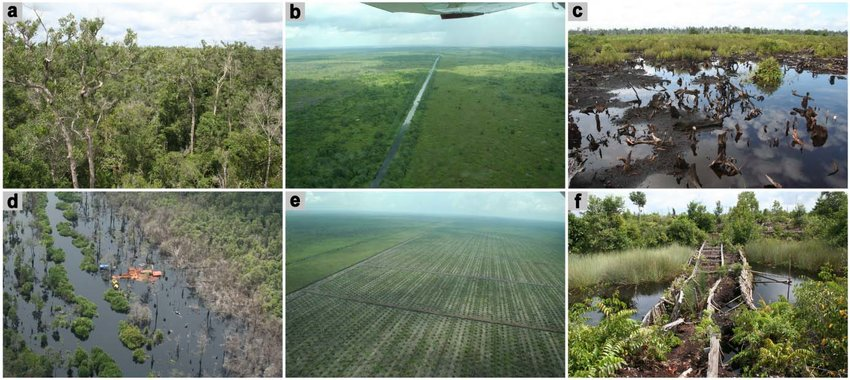
JAKARTA, INDONESIA - A recent report reveals that rampant development has placed nearly half of Indonesia's wetlands at risk of flooding, with a staggering six million hectares (twice the size of Belgium) identified as highly vulnerable.
The report, published by wetland monitoring group Pantau Gambut, surveyed three key wetland regions in Indonesia: Sumatra, Kalimantan (the Indonesian part of Borneo), and Papua (the Indonesian part of New Guinea). Each region presents distinct geographical and climatic characteristics. Kalimantan is characterized by low-lying coastal peatlands with high rainfall, while Sumatra includes both inland and coastal wetlands. Papua exhibits the most complex topography, with wetlands spread across inland, coastal, and mountainous areas and very high rainfall.
The findings indicate that at least 25% of Indonesia's total wetlands face a very high risk of flooding, with an additional 18% at medium risk. This means that 43% of Indonesia's 24 million hectares of wetlands are susceptible to flooding, leaving only 57% with a low risk.
Wetlands, as inherent parts of water-rich marsh ecosystems, possess a remarkable ability to absorb significantly more water than regular soil. They can retain 100% to 1,300% of their own dry weight in water, whereas typical soil generally absorbs only 20% to 30%. However, once degraded, wetlands lose their capacity to store water effectively.
This phenomenon, termed "irreversible drying," transforms previously stored water into uncontrolled runoff, leading to floods. "The floods we are currently experiencing are not a natural cycle commonly found in wetland ecosystems," stated Wahyu Perdana, Advocacy and Campaign Manager at Pantau Gambut. "These floods are a consequence of wetland degradation resulting from inappropriate land use and mismanagement of wetland functions."
According to Kitso Kusin, a wetland researcher at the University of Palangka Raya in Central Kalimantan, another primary driver of wetland flooding is land subsidence, the compression of wetland soil. He explained that draining wetlands, often for the construction of industrial agriculture canals, causes the soil to compact, reducing its water absorption capacity. The remaining dry peat layers become highly flammable, and this combination of subsidence and fire has been a major cause of wetland destruction across Indonesia.
The Severity of Wetland Degradation
Wetland subsidence and fires are largely driven by the expansion of businesses into wetland areas. Despite efforts to curb such development, deforestation in wetlands remains high, with approximately 50,000 hectares lost annually, according to Juma Maulana, a Geographic Information System Researcher at Pantau Gambut.
Many wetland hydrological units – naturally bounded by rivers and/or the sea, and rich in carbon – overlap with industrial zones. Pantau Gambut estimates that 8 million hectares, or 33% of these units, are located within development areas, placing them at high risk of drainage and clearing. Once degraded, restoring wetlands to their original state can take decades or even centuries, and in many cases, it may be impossible regardless of the effort, Juma added.
"Restoration cannot fully return wetlands to their original condition, but it can slow down the rate of environmental destruction," Kitso noted.
Increased Inundation Risk in Coastal Areas
The impact of wetland degradation is not limited to inland regions. The Pantau Gambut report highlights that land subsidence in degraded coastal wetlands has increased the risk of tidal flooding. These wetlands, once natural barriers against seawater intrusion, are now contributing to the problem. As flood risks escalate, seawater contaminates groundwater sources, further depleting freshwater resources.
Riau Province on the eastern coast of Sumatra is particularly vulnerable. Extensive coastal wetland degradation has significantly altered the landscape, increasing the frequency and severity of flooding. Settlements, agricultural land, and entire coastal ecosystems in Riau are increasingly being swallowed by the sea.
The coastal city of Dumai in Riau, where 80% of its area consists of wetlands, experiences frequent flooding even without heavy rainfall. In September 2024, tidal floods inundated coastal areas and regions around the Dumai River. "This flood had a significant water level. As a result, we couldn't go to work," said Anwar (44), a Dumai resident, according to local media reports.
Severe Flood Damage in Kalimantan
Kalimantan, another region heavily affected by wetland degradation, is also experiencing increasingly severe flooding. In 2021, devastating floods in South Kalimantan province, with water levels reaching up to three meters in some areas, resulted in 15 deaths and displaced approximately 40,000 people. The disaster caused an estimated 1.34 trillion rupiah (US$81 million) in economic losses, with over 24,000 houses, infrastructure, and livelihoods destroyed.
The report notes that flooding in Kalimantan is no longer a seasonal occurrence but happens year-round, indicating permanent landscape damage. Half of the wetlands in this region are classified as being at very high risk of flooding, with South Kalimantan being the hardest hit. According to the report, nearly 80% of South Kalimantan's wetlands are severely degraded and face an extreme risk of flooding.
Policy Recommendations and the Need for International Cooperation
Pantau Gambut argues that the Indonesian government has yet to adequately address the flood risks associated with wetland degradation. Authorities primarily associate wetland damage with fires, overlooking the equally destructive impacts of drainage and land subsidence. Consequently, policies focus on fire prevention and fail to address the hydrological collapse of wetlands, leaving flood risks poorly managed, Pantau Gambut criticizes.
The organization emphasizes the need to incorporate an ecosystem-based hydrological approach into policies, one that addresses the broader impacts on hydrological cycles and flood risks beyond fire prevention, to prevent further degradation.
Internationally, stronger regulation of wetland ecosystems is needed, particularly within the European Union Deforestation Regulation (EUDR). Set to take effect later this year, the EUDR aims to prevent the import of products linked to deforestation and ecosystem destruction into the European Union. Under this regulation, companies must prove that commodities such as palm oil, timber, rubber, and soy have not been sourced from land deforested after December 31, 2020.
Indonesia, the world's largest palm oil producer and a major timber exporter, is significantly impacted by this regulation. However, the EUDR's current definition of deforestation follows the United Nations Food and Agriculture Organization (FAO) model, focusing on tree cover loss rather than hydrological ecosystem destruction.
As a result, severe forms of ecosystem damage like wetland drainage, subsidence, and flooding are not explicitly considered in EUDR assessments. This loophole allows companies to drain wetlands to establish plantations and export to the EU while causing significant environmental harm, Pantau Gambut points out.
The organization warns that if the EU does not recognize wetland destruction as a form of deforestation, it risks undermining Indonesia's wetland restoration efforts and driving further degradation.
Domestically, Pantau Gambut urges the Indonesian government to revise its 2016 regulation on wetland protection and management to include flood risk indicators as a key measure of degradation. The current regulation primarily focuses on preventing forest and land fires. Additionally, they advocate for expanding corporate responsibility for wetland damage. Currently, companies are only held accountable for fire-related damage, but the regulation should be extended to include accountability for flood risks caused by wetland drainage, the organization argues.
"If these measures are not taken, not only will endemic flora and fauna be affected, but the floods resulting from wetland degradation will directly impact human survival," Pantau Gambut warns in its report. "If wetland ecosystems, which should store water, become inundated due to widespread environmental destruction, everyone will bear the consequences."
[Copyright (c) Global Economic Times. All Rights Reserved.]






























